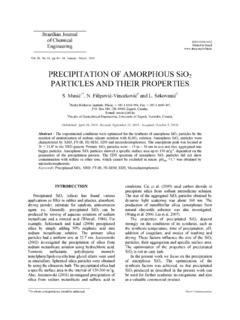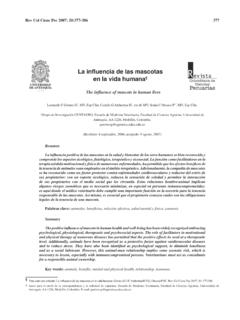Transcription of Critical Theory and Social Justice* - SciELO
1 Brazilianpoliticalsciencereview RESEARCH NOTE. Critical Theory and Social Justice*. lvaro de Vita Universidade de S o Paulo, Brazil I n Elements of a Critical Theory of Justice, the Uruguayan political philosopher Gustavo Pereira (2013a) does an admirable job of combining, in an original the- oretical formulation, contributions for reflection on the nature of justice in a democratic society, deriving from two distinct traditions of contemporary political philosophy. One tradition is the Critical Theory of society, as expressed in writings by the contemporary heirs of the Frankfurt School, especially J rgen Habermas, Karl-Otto Apel and Axel Hon- neth. Let me call the other tradition post-Rawls theories of justice . At least for the aims of the present article, this latter broad category can include the theoretical formulations of authors who have significant differences with Rawls, such as G.
2 A. Cohen, Amartya Sen and Martha Nussbaum. The idea is to propose a Critical Theory of justice or, we might say, a conception of Critical Social justice. The basic elements of this conception are extracted from theoretical perspectives that belong to these two traditions and are then articulated in a new and systematized fashion, in such a way that the new Theory can overcome the shortcomings of the original theories and express a higher commitment to application (PEREIRA, 2013a, p. 05). The intellectual ambition of this effort can hardly be underestimated. Regardless of how one appraises the success of this project by judg- ing it according to its most ambitious aspirations, the discussion developed by Pereira to specify the elements of his conception of Critical Social justice makes this book highly relevant for students of normative political Theory , especially those concerned with Social justice issues.
3 It would be impossible to summarize here all the steps of the intricate reasoning of an essentially conceptual nature by which Pereira articulates elements from theoretical perspectives of both traditions mentioned above to build his own Theory of Critical Social justice. In fact, the discussion that follows is quite selective. It consists essentially of an indication of a number of controversial issues that an undertaking like this brings up, * 109. bpsr lvaro de Vita especially when considered from the point of view of Rawlsian justice. Two preliminary observations are necessary regarding the scope of this discussion. The first observation is that, even though I stated above that Pereira combines elements taken from the two philo- sophical traditions in question here, it is a theoretical effort that, in its most characteristic aspects, remains solidly located within the intellectual structure of the Critical Theory .
4 It would be a mistake, therefore, to characterize it as an attempt at theoretical syncretism. But what I want to stress, as a note of caution, is that the appropriation Pereira makes of the Critical Theory will not be discussed in this article1. This leads us to the second obser- vation. My purpose here is to examine a theoretical effort to formulate, mainly on the ba- sis of the Critical Theory , a conception of Social justice that is capable, or so it is argued, of dealing with certain deficiencies (which will be described shortly) of Rawlsian justice in a normatively appropriate way. It is the Critical interlocution with the Rawlsian perspective that constitutes the focus of the concern behind this article. Beyond presenting a review of Gustavo Pereira's book, what I intend to do here is to bring up controversial issues that de- serve further research efforts by practitioners of political Theory who dedicate themselves to normative reflection on Social justice.
5 According to Pereira, Critical Social justice should appropriately take on questions of foundation and questions of application of a criterion for Social and political justice. The questions of normative foundation are faced by referring to the discourse ethics of Haber- mas and Apel. On the basis of the universalization principle, formulated by Habermas, a valid criterion of justice, like all moral norms that have any pretension to normative validity, should satisfy the following norm of dialogical argumentation: All [those] affect- ed can accept the consequences and the side effects [that] its [a proposed moral norm's]. general observance can be anticipated to have for [the] satisfaction of everyone's inter- ests (and these consequences are preferred to those of known alternative possibilities for regulation) (HABERMAS, 1990, p. 65, italics suppressed).
6 The next step in Pereira's construction consists of sustaining that Habermas's universalization principle should be complemented by Apel's co-responsibility principle (PEREIRA, 2013a, ), which, for Pereira, already represents a step towards applicability. This principle establishes the co-responsibility of the potential participants in the argumentative discourse to contrib- ute to the abolition of the injustices that exist in real societies. By preventing the citizens involved in the communicative interaction from adequately participating in the dialogue, these injustices also prevent the attainment of discursive solutions to controversial moral questions in conformity with the universalization principle. But Pereira's greatest concern is not with questions of normative validity. He notes Apel's statement to the effect that discourse ethics is comprised of two parts, one being 1 Here I answer to a comment made by an anonymous reviewer of this journal.
7 110 (2014) 8 (1) 109 - 126. bpsr Critical Theory and Social Justice Part A, referring to normative validity, and the other, Part B, focused on Social and political justice and on applied ethics. Pereira then goes on to stress that my interest is restricted to Social and political justice (PEREIRA, 2013a, ). Although he does not specifically say so, it is implied that the greatest deficiency of Habermas's and Apel's dis- course ethics lies in not being concerned (to the necessary extent) with the conditions that allow for the realization of the ideal community of communication in the real com- munity (PEREIRA, 2013a, p. 57). One of the main aims of Pereira's book, as far as the Critical Theory is concerned, is to fill in for this failing of Part B of discourse ethics. An- other important aim is to show that this can be done by formulating a normative criterion and a conception of Social justice that can offer a more morally appealing alternative than that which the liberal-egalitarian conceptions of justice can offer than Rawls's perspec- tive in particular to address, especially, two problems seen as interconnected.
8 These two problems are, namely, that of the specification of the scope of a Theory of Social justice and that of the constitution, among the citizens, of the motivational structure that is needed for a person to become an agent of justice and commit herself to the realization of justice in society. Pereira holds that, by offering more adequate answers to these two problems, the Critical Theory of justice can be considered superior to Rawls's Theory as to how the relationship between a model of ideal justice, and its application to real societies, should be conceived. As compared to the Rawlsian perspective, therefore, it is based on this question of applicability that one should appraise the credentials of Critical Social justice. This question will be the main focus for the remarks that follow and, of course, they will in no way exhaust the discussion of all the conceptual elements that Pereira deals with in articulating his conception of justice.
9 Let us start with the central element of this conception. Since Pereira is concerned with Part B of discourse ethics, he holds that there must be a conceptual element that articulates the normative point of view of discourse ethics with a conception of justice highly committed to intervention [in] and transformation of actual societies (PEREIRA, 2013a, p. 102). This conceptual element provides a normative guide for selecting princi- ples of justice and, especially, a metric for Social justice. Specifically, he is referring to the idea of reciprocal recognition autonomy, which is the guiding principle of the book. For Pereira, a central component of any normative conception of justice is an idealization of subjects able to demand justice and give support to just institutions and just policies. For a Theory of justice that is in conformity with the normative foundation of discourse ethics, this idealization is expressed through an idea of autonomy, understood as the capacity to take part in dialogue by offering and accepting reasons to support one's claim (PEREI- RA, 2013a, p.)
10 61). 111 (2014) 8 (1) 109 - 126. bpsr lvaro de Vita As the form of autonomy that should provide the telos of Social justice is that of reciprocal recognition, the moral language used is that of recognition. The central con- ceptual and normative element of Pereira's Critical Theory is taken from Honneth's the- ory of recognition. An initial comment should be made on this point. For authors such as Charles Taylor, Iris Young and even Nancy Fraser, the idea of the recognition of the cultural identities of groups that suffer experiences of Social discrimination and stigmati- zation is placed in contrast to, or at least in strong tension with, what Taylor (1994) calls the politics of equal dignity. For the latter idea, the realization of justice in society has the purpose of guaranteeing a form of equal treatment that is only possible for those who, as citizens, are bearers of equal rights.











